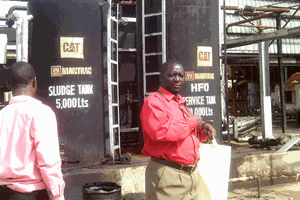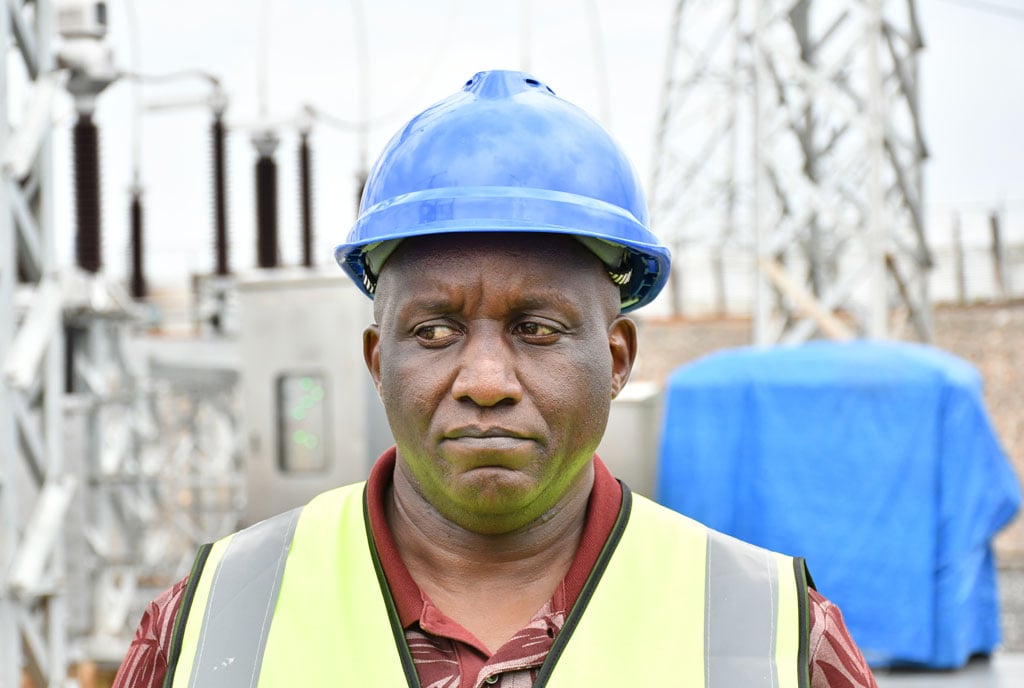
President Museveni, Vice President Jessica Alupo and other officials inspect the Nebbi sub-station in Nebbi District on August 3, 2026. PHOTOs/FELIX WAROM
The drums beat in Nebbi Town on Saturday. The sound of traditional Alur music rang out to a choreographed motion by dancers.
Then a band-led procession trumpeting revolutionary songs thundered to headline a march by ruling party loyalists dressed in yellow, the official National Resistance Movement colour.
The population milled and the cacophony which animated Nebbi Town invoked a semblance of campaign euphoria.
Yet, nominations of candidates for the next ballot are roughly a year ahead, according to the Electoral Commission-issued revised blueprint.
Saturday wasn’t a day for vote-canvassing rally, but the hallmarks of similarity were hard to miss.
At 11:20am, the chuff, chuff of the helicopter echoed, signalling the imminent arrival of President Museveni. Within moments, the whirring blades of the helicopter were visible.
The crowd roared and surged as the helicopter rotated over Namthin Primary School. On the ground, a line of vehicles chauffeuring dignitaries involved in welcoming the President powered in his direction at break-neck speed.
The atmosphere was electric for an event held to onboard the whole of West Nile, for the first time in its 110-year history as part of Uganda, onto the national grid.
It was a landmark ceremony that Mr Museveni was unlikely to delegate, despite its scheduling on a weekend, considering decades of harsh criticism he and his government endured over the power problem, and the political dividends expected of switching the region onto the national grid.
Before long, the President was out of the helicopter and at Nebbi sub-station at Thatha Ward, Nebbi Municipality, thronged by an array of leaders – political, civil, religious, cultural and civil society.
He ripped a tape open, the traditional way of commissioning tangible things in Uganda, and entered the sub-station from where he, with a computer mouse, clicked the cursor to formally onboard West Nile onto the national power grid.
Outside, the crowd yodelled, marking a break figuratively from darkness to light.
And as the excitement died down, a sketch line of the important question – what next? – formed on the arc of the envisaged socio-economic transformation of the region now that the electricity jinx was over.
President Museveni didn’t mince his words, exhorting residents to use the power productively to spur development and change lives for the better, but not before offering a detailed account for the inordinate delay in connecting West Nile to the national grid.
First hurdle, he noted, was low demand: 2.5 megawatts. Secondly, according to Mr Museveni, the 33-kilovolt line from Kole would lead to energy loss in transmission to the region.
“We had to build this 132-kilovolt power line that would be able to supply power to the West Nile. And that time, the demand was low, so we could not connect. Now that there is demand, we need to utilise the 90 megawatts through attracting investors who will establish factories,” he said, referring to the new quantum of energy supply to the region.
Statistics from the Energy ministry indicate that the current uptake by the region’s 12 districts and Arua City is 6 megawatts, which is projected to rise to 10 megawatts over the next 12 months.
Among those dialling in for the power, officials indicated, are neighbouring Democratic Republic of Congo and South Sudan.
“The people of West Nile, mac tiye madit ii dero (there is plenty of power in the granary) now waiting to be consumed. We now need to set up the industrial parks in West Nile to consume the power,” the President said amid ululations.
An industrial and business park is proposed to be established in Pakwach, Koboko, Yumbe and Adjumani districts.

President Museveni unveils the Nebbi sub-station in Nebbi District on August 3, 2024.
The electricity is expected to reboot investments such as the brewery in Parombo and cotton ginnery, both in Nebbi, a water factory in Zombo District, a tobacco factory in Ajia, Arua District, and a fruit factory in Arua City and Yumbe District, respectively, long malnourished by blackouts and high energy costs.
Down the pipeline are other beneficiaries: schools where learners can be certain to study once the sun goes down, the bar owner who can serve chilled drinks, the poultry farmer who can warm the pen or run the machines, and the public who can walk lit urban streets at night besides projected drop in crime.
In the Saturday commissioning of the 132KV Kole-Gulu-Nebbi-Arua transmission line, which connects West Nile to the national power grid, President Museveni paid an old debt of a battle fought by different generations of the political elite, religious leaders and the masses.
Among the clerics was the then Arua Diocese Bishop Fredrick Drandua, now deceased, who in the late 1980s and 1990s had lobbied $30m from Italian friends to build a hydro dam on River Nyagak in present-day Zombo District.
He told this newspaper in an interview in 2015 that the government declined to offer a $2m part funding, leaving the project to collapse to much chagrin of West Nilers.
“I saw the need for power for us to develop because we had lagged behind in development. Power is essential in the development of any place because investors would set up their factories which can then employ several people from here and other regions. But I feel sad that my friends went back to Italy disappointed that they were not allowed to invest in the region,” the bishop said at that time.
Famed for building schools, sponsoring dozens of the needy to study and championing holistic development of the church and Christians, the late Drandua was a venerated cleric and household name for hope.
Thus, that an energy project he had initiated fell apart even before it started spread dislike for the government in ways it was predictable, as it happened until 2016, that President Museveni would lose any election in West Nile.
The discontent was partly explainable and understandable: Museveni had been among different groups that fought against the government of Idi Amin, who hailed from the region, and his kins and loyalists here were unlikely to warm up to a new head of state whose grab of power cancelled the perks of the ousted.
In the midst of the political acrimony marked by the formation of rebel groups to fight Museveni’s government, which unexpectedly had in 1986 been received in West Nile without a fight, mistrust between Movement ideologues and luminaries in the region heightened.
The legitimate words of opposition off the tongues of leaders in the region were difficult for the government to distinguish from the bullets of the barrels of fighting groups such as Uganda National Rescue Front I and II and West Nile Bank Front.
In the ensuing kerfuffle, political leaders from West Nile regions such as late Nick Nyai and firebrand Constituent Assembly Delegate Zubair Atamvaku claimed marginalisation of the region by the NRM government which was unresponsive at the time to demands for upgrade of the West Nile highway to bitumen standard and its connection to national power grid.
As the bickering continued, unrelatedly, something unexpected happened to the much loved Bishop Drandua: an assassination plot during Mass at Christ the King Church in Arua City centre.
Rather than shoot the man of God, the would-be assassin Moses Azumaga, then a Mvara SS student who has since died, turned over to Drandua a pistol that he said had been given to him by a senior government official to shoot the bishop.
News of the plot consumed the region, riling natives, adding to a toxic mix of claims that his plans to build a dam to generate electricity to prosper West Nile had been hamstrung by the government.
At the Saturday function in Nebbi Town, President Museveni, in comments unrelated to these accounts, said the set of historical facts to his knowledge differs from the common claims.
“The argument by some people who say that we had forgotten West Nile were wrong, they were not serious, they were disruptive actually,” he said.
When he seized power in 1986, President Museveni said he found Owen Falls Dam was generating only 60 megawatts (out of an installed 150 megawatts), half of which was being supplied to Kenya under the colonial-era arrangements.
His government repaired the dam and rebooted additional generators to increase the dam’s output to 180 megawatts, 3o megawatts of which still serviced Kenya.
Electricity supply, he said, outstripped demand in the country only after the construction of Bujagali, Isimba and now Karuma hydro-dams on the back of his 2006 directive to the Cabinet to prioritise infrastructure development.
Energy and Mineral Development minister, Ms Ruth Nankabirwa, who has lately taken the heat for the delayed connection of the region, had a shy of relief on Saturday.
“The question of power connections has been lingering for a long time in West Nile. Now it has been answered and I know there will be more questions following, especially the connection of Obongi,” she said of the only district of the region without powerlines.
She committed Obongi would be connected sooner, as will rural outposts under a tailored project to increase access.
Mr Kwame Ejalu, the chair of the board of Uganda Electricity Transmission Company Limited (UETCL), reported on Saturday that “as of July 2024, UETCL’s total grid length stood at 4,962.4 km with … 42 substations and a transformation capacity of 6,945.5 MVA, … [including] 132/33kV Kole – Gulu – Nebbi - Arua transmission line and associated substations.”
Vice President Jessica Alupo switched on the Arua link to the national grid after the commissioning ceremony in Nebbi.
The National Female Youth MP Phiona Nyamutoro, named state minister for Minerals only in March, was ecstatic too and asked for more.
“Now that we have the power, we should fast-track the Nebbi-Goli-Paidha- Warr-Vurra road so that the agricultural and manufacturing materials are easily transported to the factories that will be established and to the market,” she said, taking similar lines echoed yesterday by Church of Uganda Archbishop Emeritus Luke Orombi.

Some of the guests who attended the function follow proceedings at the Nebbi sub-station.
According to Ayivu East MP Geoffrey Feta, who is the new vice chairperson of the Environment and Natural Resources Committee of Parliament, tapping West Nile onto the national power grid is a “fundamental change”
“We had a long struggle for this historic occasion,” he said, “This power will influence industrialisation … [to create jobs and] accommodate manual, skilled and semi-skilled labourers.”
Former Ayivu MP Bernard Atiku struck a similar chord, retailing the region’s demographic dividend and strategic location as an investment destination to service nearby South Sudan, DRC, Central African Republic, and Chad.
“This will translate into increased household income earnings, poverty reduction, improved standard of living and increased life expectancy. The real social-economic transformation of West Nile is now set to begin,” he added.
Mr Simon D’Ujanga, a former long-time junior Energy minister, reminisced that “what we started several years ago has now come to reality”.
“Now our people need to reap from this power to the fullest,” he noted.
About the project
The World Bank through its lending arm, the International Development Association (IDA), financed the construction of the transmission line infrastructure with $100m while the government mustered Shs31.3b to resettle persons affected by the project.
The design, supply and installation of the 132kv Kole-Gulu-Nebbi-Arua transmission line was implemented by KEC International Limited while the design, supply and installation of the 132kV Kole Switching Station and 132kV Gulu Sub-stations, with associated 33kV Interconnection lines, was implemented by the Joint Venture of AVIC International Holding Corporation and Central Southern China Electric Power Design Institute Co Ltd (China).



